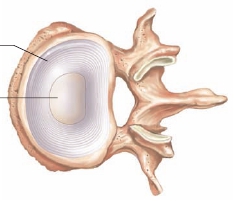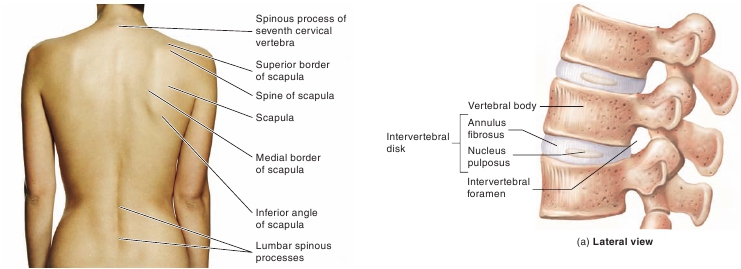CHAPTER 7 Skeletal System: Gross Anatomy

217

FIGURE 7.14
Surface View of the Back, Showing the Scapula
and Vertebral Spinous Processes
Annulusfibrosus
processes can be seen and felt as a series of lumps down the midlineof the back (figure 7.14). Much vertebral movement is accom-plished by the contraction of the skeletal muscles attached to thetransverse and spinous processes (see chapter 10).The location where two vertebrae meet forms the
intervertebral foramina
(table 7.9
d
; see figure 7.13). Eachintervertebral foramen is formed by
intervertebral notches
in thepedicles of adjacent vertebrae. These foramina are where spinalnerves exit the spinal cord.Movement and additional support of the vertebral column are madepossible by the vertebral processes. Each vertebra has two
superior
and two
inferior articular processes,
with the superior processesof one vertebra articulating with the inferior processes of the nextsuperior vertebra (table 7.9
c,d
). Overlap of these processes increasesthe rigidity of the vertebral column. The region of overlap and articu-lation between the superior and inferior articular processes creates asmooth
articular facet
(fas′et; little face) on each articular process.
Nucleuspulposus
(b)
Superior view

FIGURE 7.15
Intervertebral Disk
figure 7.13) have very small bodies; most have
bifid
(b ī ′fid; split)
spinous processes
and a
transverse foramen
in each transverseprocess through which the vertebral arteries extend toward thehead. Only cervical vertebrae have transverse foramina. Becausethe cervical vertebrae are rather delicate and have small bodies,dislocations and fractures are more common in this area than inother regions of the column.The first cervical vertebra is called the
atlas
(figure 7.16
a,b
)because it holds up the head, just as in classical mythology Atlasheld up the world. The atlas has no body and no spinous process,but it has large superior facets, where it articulates with the occipitalcondyles on the base of the skull. The joint between the occipitalcondyles and the atlas allows the head to move in a “yes” motionand to tilt from side to side. The second cervical vertebra is calledthe
axis
(figure 7.16
c,d
) because a considerable amount of rotationoccurs at the axis to produce a “no” motion of the head. The axishas a highly modified process on the superior side of its small bodycalled the
dens,
or
odontoid
( ō -don′toyd; tooth-shaped)
process.
The dens fits into the enlarged vertebral foramen of the atlas, andthe atlas rotates around this process. The spinous process of the sev-enth cervical vertebra, which is not bifid, is quite pronounced and
Intervertebral Disks
During life,
intervertebral disks
of fibrocartilage, which are locatedbetween the bodies of adjacent vertebrae (figure 7.15 and table 7.9;see figure 7.13), provide additional support and prevent the vertebralbodies from rubbing against each other. The intervertebral disksconsist of an external
annulus fibrosus
(an′ ū -l ŭ s f ī -br ō ′s ŭ s; fibrousring) and an internal, gelatinous
nucleus pulposus
(p ŭ l-p ō ′s ŭ s;pulp). The disk becomes more compressed with increasing age, sothe distance between vertebrae—and therefore the overall height ofthe individual—decreases. The annulus fibrosus also becomesweaker with age and more susceptible to herniation.
Regional Differences in Vertebrae
The vertebrae in each region of the vertebral column have spe-cific characteristics that tend to blend at the boundaries betweenregions (table 7.10). The
cervical vertebrae
(figure 7.16; see